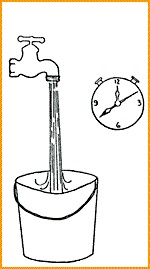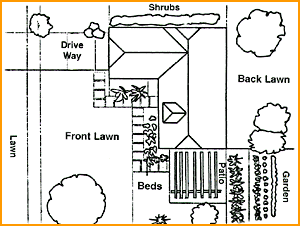Before you begin, find your water capacity (which determines your system size).
Time how long it takes to fill a bucket of known volume. The tap should be the closest one to the meter or water source, and fully open before placing bucket under tap, with no other taps or valves in use. (Below)

Knowing the pressure is important in an irrigation system but the flow rate (litres/minute) from the water source is more important for a domestic system. If you are unsure on the calculation then contact or visit us for assistance.
Planning your installation: The first step in laying out your system is to decide which areas you want to water. (Below)

Plot the locations of areas to water: Using a grid, plot the outlines of your home and garden areas. Include paths, driveways and patios. Use a tape measure for accuracy. Make sure all areas match the scale of the grid and label each area according to type of foliage (eg. lawn, shrubs, flower bed, etc.) Mark positions of mains water meter and tap positions. Also mark position of bore on block or other water sources, such as dams, rivers or tanks.
When you have accurately drawn a diagram of your home and garden, email it to us at or bring it in to our showroom at 465 Brighton Road, Brighton, South Australia. Please include your contact details in the email, and whether your water source is via pump or mains supply, whether you require a manual or automatic, and whether it is to be powered by batteries or mains power.
We have qualified installers we can recommend or come in to the store and we will go through the design and show you how to use the products.
If you plan to install it yourself, here are a few tips:
If you plan on laying concrete or pavers before your irrigation system then it is crucial to run pipes under the paths with the pipes needed for your designed system. If you have not designed a system yet then you can bury a sleeve so future pipes can be installed under the path. A sleeve is usually a large diameter P.V.C pipe i.e. storm water or sewer pipe.
If the water source is from the mains supply and a new cut-in supply is needed then consult a licensed plumber in regards to backflow prevention requirements and devices needed. A plumber can also install a new valve or tap to supply water to your new irrigation system.
If digging trenches by hand, soften your soil by watering the ground about two days before you plan to trench your yard.
Check your gas, electricity, telephone and pay TV companies to be sure there are no buried lines where you plan to dig.
Low density poly pipe should only be used between the valves and the sprinklers/drippers. Low density black poly cannot withstand the surge pressure between your service line and valves and high pressure blue line poly or P.V.C pressure pipe must be used.
The tops of pop-up sprinkler heads and rotors should be slightly above the soil surface and no higher. It is much easier to raise a sprinkler than lowering a sprinkler after the system is installed.
The controller/timer
If a power point is available out of weather, a plug-in transformer may be used. Otherwise weatherproof controllers are available for outdoor use. Irrigation electrical cable has to be installed between the controller and solenoid valves. If this seems impractical then battery operated controllers can be installed.
Please contact us on 08 8377 1135 if you have any questions

